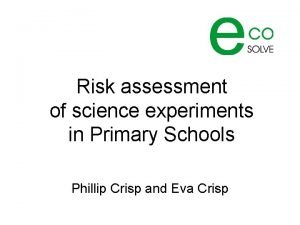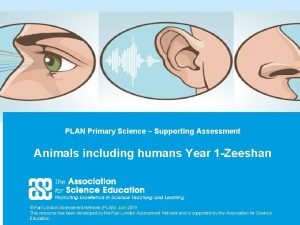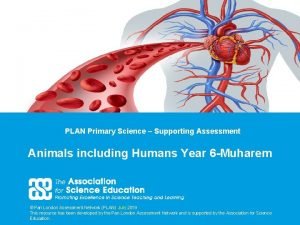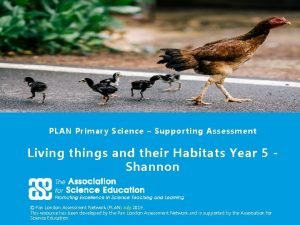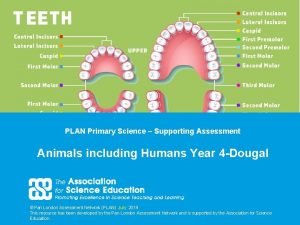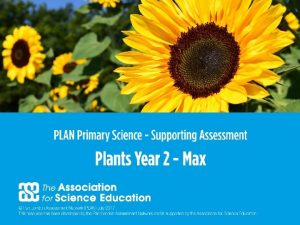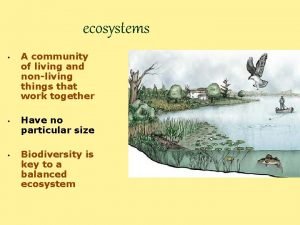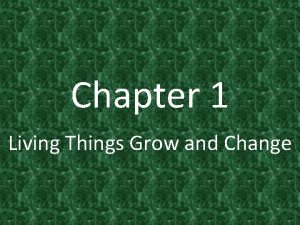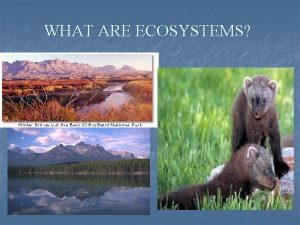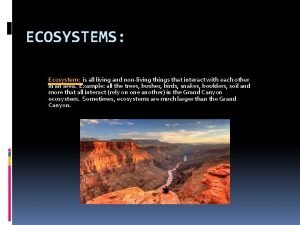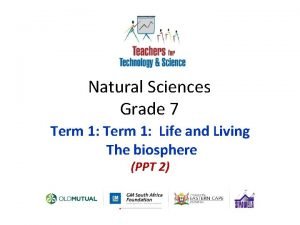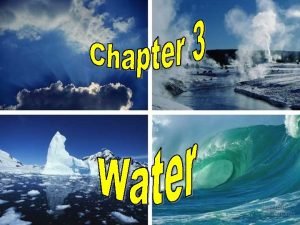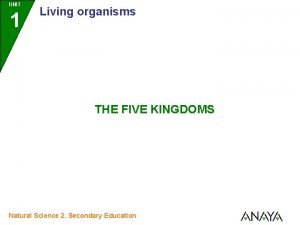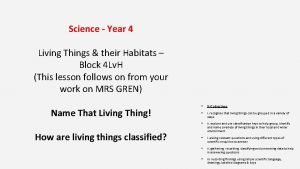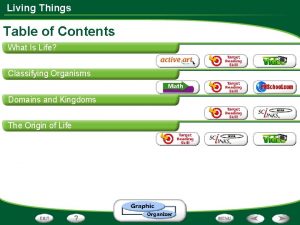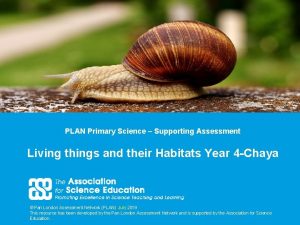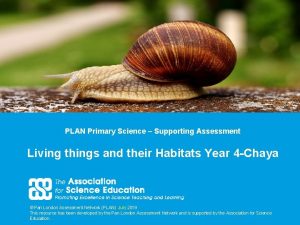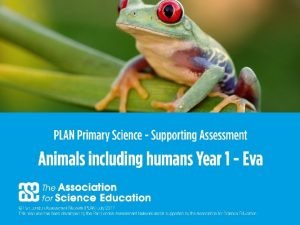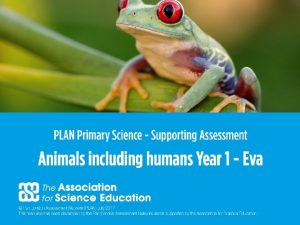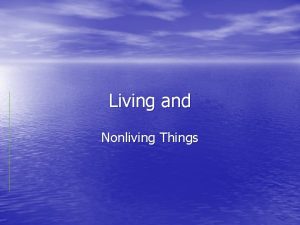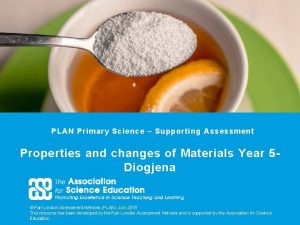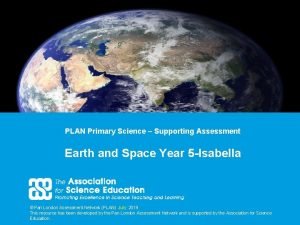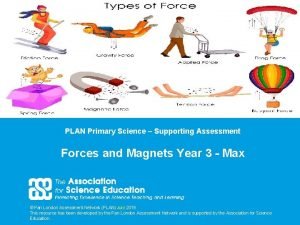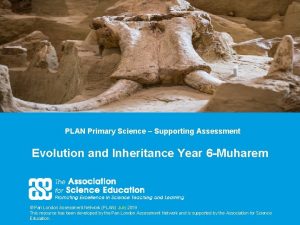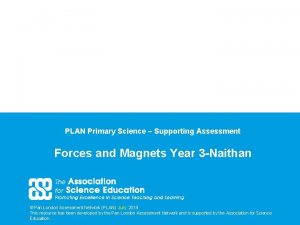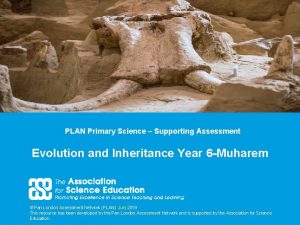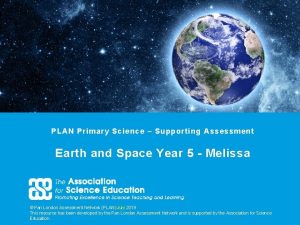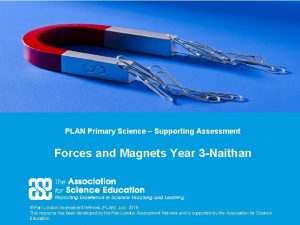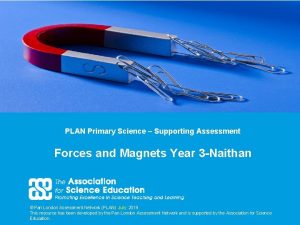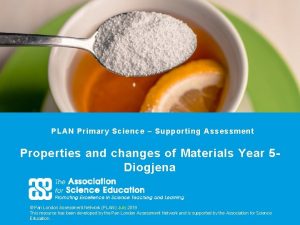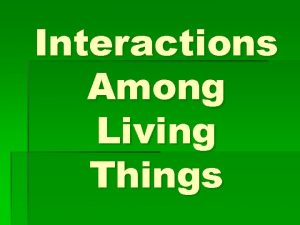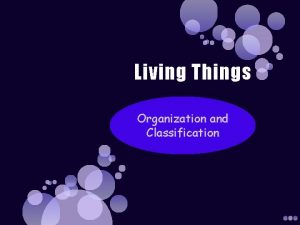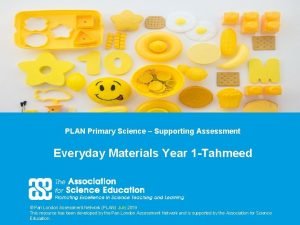PLAN Primary Science Supporting Assessment Living things and



























- Slides: 27

PLAN Primary Science – Supporting Assessment Living things and their Habitats Year 2 -Max © Pan London Assessment Network (PLAN) July 2019 This resource has been developed by the Pan London Assessment Network and is supported by the Association for Science Education. 1

PLAN Primary Science - Supporting Assessment PLAN Primary Science is a set of resources produced to enable teachers to have a clearer understanding of National Curriculum expectations for meeting the standard. Annotated collections of children’s work provide examples of what working at the expected standard for primary science might look like for the knowledge and conceptual understanding statements of the programmes of study (POS). It is not the intention of these resources to specifically exemplify the working scientifically statements. However, aspects of working scientifically have been shown as an integral part of the teaching and learning of the knowledge and concepts. The resources provided have been cross moderated multiple times before publishing so that they can be used with confidence by teachers and subject leaders. Each collection of work shows one example of how a pupil has met National Curriculum statements for a particular area of content but these are not intended to be the definitive way of teaching these statements. 2

Structure of the resources Each resource contains the relevant National Curriculum statements for the unit of work and prior learning, a planning matrix, annotated work and a summary sheet. The matrix provides an interpretation of the key learning of the National Curriculum statements, and suggestions of key vocabulary. In order to be meet the expectations pupils must firstly understand the key concept and then be provided with opportunities to apply that knowledge. This is a key planning tool. Key Learning Secure Possible Evidence Show understanding Overview paragraph describing of a concept by curriculum using scientific vocabulary correctly Key vocabulary – list of words Possible ways to demonstrate key learning, particularly correct usage of vocabulary Apply knowledge in Suggestions of contexts to use. familiar related contexts across a range of enquiry types Possible ways to demonstrate that a pupil has gone beyond recall of facts and can apply the key learning, for example using the vocabulary and basic principles to produce explanations, usually within Working Scientifically contexts. 3

Contents of the materials Please note: The NC statements for each topic area for the relevant year group are stated on the slide. Only the statements in bold on that slide have been exemplified. In these cases the teachers have chosen to split the statements within the topic area to teach at different times. The prior NC statements relevant to the topic area are also stated and use to determine pupils’ knowledge at the start of the unit. Each slide has been annotated with coloured text. Please see key below: Red statements Blue Commentary to explain how evidence meets/does not meet NC Commentary to highlight features of working scientifically Green Pupil Speak Grey Other relevant information eg. vocabulary used 4

Year 1 statements Pupils should be taught to: • identify and name a variety of common wild and garden plants, including deciduous and evergreen trees (1 -Plants) • identify and describe the basic structure of a variety of common flowering plants, including trees (1 -Plants) • identify and name a variety of common animals including fish, amphibians, reptiles, birds and mammals (1 -Animals including Humans) • identify and name a variety of common animals that are carnivores, herbivores and omnivores (1 -Animals including Humans) • describe and compare the structure of a variety of common animals (fish, amphibians, reptiles, birds and mammals, including pets) (1 -Animals including Humans) • observe changes across the four seasons (1 -Seasonal Changes) 5

Year 2 statements Pupils should be taught to: • explore and compare the differences between things that are living, dead, and things that have never been alive (2 -Living things and their Habitats) • identify that most living things live in habitats to which they are suited and describe how different habitats provide for the basic needs of different kinds of animals and plants, and how they depend on each other (2 -Living things and their Habitats) • identify and name a variety of plants and animals in their habitats, including micro-habitats (2 -Living things and their Habitats) • describe how animals obtain their food from plants and other animals, using the idea of a simple food chain, and identify and name different sources of food (2 -Living things and their Habitats) 6

Later Statements Pupils do not need to be taught content they will learn in later year groups. They can be challenged by applying the content for their year group in broader contexts. In Year 4 pupils will be taught to: • recognise that living things can be grouped in a variety of ways (4 - Living things and their Habitats) • explore and use classification keys to help group, identify and name a variety of living things in their local and wider environment (4 - Living things and their Habitats) • recognise that environments can change and that this can sometimes pose dangers to living things (4 - Living things and their Habitats) • construct and interpret a variety of food chains, identifying producers, predators and prey. (4 -Animals, including Humans)

Key learning Possible Evidence Shows understanding of a concept using scientific vocabulary correctly All objects are either living, dead or have never been alive. Living things are plants (including seeds) and animals. Dead things include dead animals and plants and parts of plants and animals that are no longer attached e. g. leaves and twigs, shells, fur, hair and feathers (this is a simplification but appropriate for year 2 children). An object made of wood is classed as dead. Objects made of rock, metal and plastic have never been alive (again ignoring that plastics are made of fossil fuels). Animals and plants live in a habitat to which they are suited which means that animals have suitable features that help them move and find food and plants have suitable features that help them to grow well. The habitat provides the basic needs of the animals and plants – shelter, food and water. Within a habitat there are different micro-habitats e. g. in a woodland – in the leaf litter, on the bark of trees, on the leaves. These micro-habitats have different conditions e. g. light or dark, damp or dry. These conditions affect what plants and animals live there. The plants and animals in a habitat depend on each other food and shelter etc. The way that animals obtain their food from plants and other animals can be shown in a food chain. Key vocabulary: Living, dead, never been alive, suited, suitable, basic needs, food chain, shelter, move, feed, names of local habitats e. g. pond, woodland etc. , names of micro-habitats e. g. under logs, in bushes etc. Can find a range of items outside that are living, dead and never lived Can name a range of animals and plants that live in a habitat and micro-habitats that they have studied Can talk about how the features of these animals and plants make them suitable to the habitat Can talk about what the animals eat in a habitat and how the plants provide shelter for them Can construct a food chain that starts with a plant and has the arrows pointing in the correct direction Applying knowledge in familiar related contexts, including a range of enquiries Explore the outside environment regularly to find objects that are living, dead and have never lived Classify objects found in the local environment Observe animals and plants carefully, drawing and labelling diagrams Create simple food chains for a familiar local habitat from first hand observation and research Create simple food chains from information given e. g. in picture books (Gruffalo etc. ) Can sort into living, dead and never lived Can give key features that mean the animal or plant is suited to its micro-habitat Using a food chain can explain what animals eat Can explain in simple terms why an animal or plant is suited to a habitat e. g. the caterpillar cannot live under the soil like a worm as it needs fresh leaves to eat; the seaweed we found on the beach cannot live in our pond because it is not salty SECURE Assessment guidance

Initial assessment activity – exploration of habitats in the playground • identify and name a variety of plants and animals in their habitats, including micro-habitats To start the topic the teacher took the children outside and asked them to spend some time looking for things that interested them. The children were very excited by the minibeasts that they found also the spider’s web. Back in the classroom the children shared with their group what animals they found and where they found them. The teacher then introduced the key vocabulary - habitat – explained that this is where a plant or animal lives. Max uses his previous experiences to find some animals. He decided to look under the logs as he has found animals there in the past. Max tests his prediction by making observations. I found a snail on the wall by that plant over there and a woodlouse under a log. Back in the classroom he elaborated: The woodlice are always under things. They must like living there. Its habitat is under things. I found the snail on the wall. That is its habitat.

Initial assessment activity – to gauge starting point of new learning in year 2 • identify and name a variety of plants and animals in their habitats, including micro-habitats The children were then asked to choose an animal they were already familiar with from a different habitat, to draw it in its habitat and to write about it. Max chose to write about a flying fish. Max has talked about the habitat of some animals that he found outside and here he considers the contrasting habitat of another animal that he is familiar with. His writing shows awareness that the fish has characteristics that enable it to survive in its habitat This shows an awareness of the animal being suited to its habitat

Scavenging for living and dead things • explore and compare the differences between things that are living, dead, and things that have never been alive Children went out and collected a range of little objects. They were then asked to think about whether the things they had collected were living or dead. What about a twig? When it was on the tree it was live but now it’s fallen off it’s dead. The leaf we picked up from the ground is dead. We shouldn’t’ve picked the flower because now it’s dead. The children were then asked to record the living and dead things they had found in the playground also add any other living and dead things they could think of. Max has included both plants and animals as living things. He gives examples of plants and animals. He includes parts of plants that are no longer attached to the plant as dead and refers to animals that we eat as dead. At this point he has not been challenged to think about parts of animals e. g. empty shells, or seeds. This needs to be explored in the future. Max sorts objects by given criteria and records his findings on a simple prepared table The woodlouse Max collected was dead already

Identifying things that have never lived • explore and compare the differences between things that are living, dead, and things that have never been alive The teacher gave each group a stone and asked them to think about whether it was living or dead. Max’s group decided that the stone was not living now and didn’t think it had ever been alive. The teacher then explained that some things have never lived. The children then looked around the classroom to find other things that had never lived. Max names a range of objects that have never lived. However at this point he has not included any objects made of wood, so it is not clear if he understands that a wooden bench is classed as dead as the wood once came from a living tree.

Assessment activity – to gauge prior understanding • identify that most living things live in habitats to which they are suited and describe how different habitats provide for the basic needs of different kinds of animals and plants, and how they depend on each other • identify and name a variety of plants and animals in their habitats, including micro-habitats The children were given a sheet which asked them to name some animals and link them to their habitat. Max named all the animals on the sheet and had the prior knowledge about their habitats. This is not sufficient to show that Max is secure as he has not explored the conditions in these habitats or considered how the animals are suited to these habitats.

Exploring two contrasting habitats • identify that most living things live in habitats to which they are suited and describe how different habitats provide for the basic needs of different kinds of animals and plants, and how they depend on each other • identify and name a variety of plants and animals in their habitats, including micro-habitats The class went out to look for animals in two different habitats – in the flower bed and under a rock. The children were asked to record what they found using the prepared table. Max named the animals he found and recorded the number found using tally marks. 14

Exploring two contrasting habitats • identify that most living things live in habitats to which they are suited and describe how different habitats provide for the basic needs of different kinds of animals and plants, and how they depend on each other • identify and name a variety of plants and animals in their habitats, including micro-habitats The children were then asked to choose one habitat to present their findings in a pictogram as they had learnt to do in maths. Max put images in the squares appropriately apart from the spider where he looked at the wrong column. 15

Choice chamber activity • identify that most living things live in habitats to which they are suited and describe how different habitats provide for the basic needs of different kinds of animals and plants, and how they depend on each other • identify and name a variety of plants and animals in their habitats, including micro-habitats The teacher showed the children a choice chamber that she had made and asked the children to talk about what sort of animals may be suitable to put into it. The children then recorded where they though the woodlice, worms and slugs would choose to go. Drawing on his knowledge from looking for animals outside he predicted where the animals would choose to go.

Choice chamber activity (contd. ) • identify that most living things live in habitats to which they are suited and describe how different habitats provide for the basic needs of different kinds of animals and plants, and how they depend on each other • identify and name a variety of plants and animals in their habitats, including micro-habitats The children were asked to write about where they thought the animals would go and then afterwards they wrote what they found out. Max has made a prediction and drawn a conclusion using his scientific knowledge In this writing Max shows that he recognises that two basic needs of animals are food and protection. 17

Different habitats • identify and name a variety of plants and animals in their habitats, including micro-habitats The teacher showed the children a video of an animal on Deadly 60 to engage their interest and asked them to consider where it might be living. To find out what the children knew about the types of animals that might live in different habitats they were asked to complete a worksheet. Max names a good range of animals that would live in each habitat. At this point there is no evidence to say that he understands how they are suited to these habitats.

Designing a new creature • identify that most living things live in habitats to which they are suited and describe how different habitats provide for the basic needs of different kinds of animals and plants, and how they depend on each other The children were asked to draw and write about a new creature that could live in a habitat of their choosing. Max can talk about an animal and describe how it is suited to a particular habitat. He considers how it will keep warm, move, catch food and protect itself. My creature lives in the Pacific ocean. It is very cold and wet there. It has blubber. It has webbed claws so it can swim faster. It is streamlined. It has spikes to keep away from predators. It is also prey. It has a kind of sucker that can come in or out. It also uses it for sucking fish close to it. It sometimes goes down to the sea bed to collect sand to 19 shoot from his fin.

Constructing food chains • describe how animals obtain their food from plants and other animals, using the idea of a simple food chain, and identify and name different sources of food Three children were given images of a flower, caterpillar and a bird and asked to order themselves according to what they eat. This was repeated with different animals. The teacher then explained that this way of displaying the information is called a food chain. She showed them how to draw the arrows in to complete a food chain. Information about what different animals ate was displayed on the board for the children to create further food chains. Max tried to start with a plant but was not sure what cod eat Max used this information to create a number of food chains. 20

Minibeast hunt • identify that most living things live in habitats to which they are suited and describe how different habitats provide for the basic needs of different kinds of animals and plants, and how they depend on each other • identify and name a variety of plants and animals in their habitats, including microhabitats The children were taken outside again in the summer to look for minibeasts. Max found a bee on a bush. When questioned as to why the bee had legs and wings Max responded “It needs to fly from flower to collect nectar so it can make honey. " This comment demonstrates that Max understands that plants and animals depend on each other The children also saw some other flying minibeasts where some wildflowers were growing that they had planted. The bees, wasps and butterflies like the poppies and cornflowers we grew. Max names plants and animals in their habitat. 21

Exploring a habitat explore and compare the differences between things that are living, dead, and things that have never been alive Whilst outside the children were given an egg box in which they were required to collect some specific objects. Back in class they were then asked to sort these objects in different ways. Max’s group chose to sort by whether they were living, dead or never lived as they remembered doing this earlier in the year. The stone has never lived. The twig, bark, leaf and seed are dead now as they have come off the tree. Mind you the seed could grow if we planted it in the right place and watered it. It’s living! This idea was followed up in a class discussion and it was decided that the seeds could indeed be classed as living. Max identifies things that are living, dead and have never been alive. 22

Observation drawing explore and compare the differences between things that are living, dead, and things that have never been alive The children were asked to make a careful observation drawing of one of the objects they had found. Max chose to draw an object that he identified as a seed case and collected a magnifying glass from the drawer to help him. Max makes a careful drawing of the seed case and chose to use a magnifying glass to be able to observe more closely. Max describes why he thinks a seed is living. 23

Exploring two contrasting habitats • identify that most living things live in habitats to which they are suited and describe how different habitats provide for the basic needs of different kinds of animals and plants, and how they depend on each other • identify and name a variety of plants and animals in their habitats, including micro-habitats On a second trip into the playground during the summer term the children were asked to record the animals they found in two different habitats. Max chose to look under stones and in the flower bed. We found way more ants and woodlice in the flower bed than under the stones. Max draws a table to record the animals he finds in the two habitats which he labels. He uses tally marks to record the number of each animal found. 24

Exploring two contrasting habitats (contd. ) • identify that most living things live in habitats to which they are suited and describe how different habitats provide for the basic needs of different kinds of animals and plants, and how they depend on each other • identify and name a variety of plants and animals in their habitats, including micro-habitats We found lots more ants than anything else in the flower bed. They were running everywhere and hard to count. We found about the same amount of bees, flies and woodlice. Max presents his data as a bar chart. He labels the axes appropriately and draws the bars to the correct height. He talks about what he found out. Max identifies and names animals he finds in two habitats that he investigates. 25

Overall Summary Overall summary – secure Max has explored habitats and microhabitats (under logs, amongst the wildflowers) and names animals and plants living in these habitats. He talks about how the animals are suited to their habitat and how the plants and animals depend on each other food and shelter. He is able to create simple food chains to show what animals in a habitat eat. He finds a range of objects in the local habitat and identifies them as living, dead or never lived. 26

Acknowledgements 27
 Whats an energy pyramid
Whats an energy pyramid The smallest living unit of all living things is
The smallest living unit of all living things is Seven life processes
Seven life processes Science risk assessment primary school
Science risk assessment primary school Primary and supporting instruments
Primary and supporting instruments Attitude + power = performance
Attitude + power = performance Plan primary science
Plan primary science Plan primary science
Plan primary science Plan primary science
Plan primary science Digestive parts
Digestive parts Plan primary science
Plan primary science My favourite subject is maths
My favourite subject is maths Ecosystem living and nonliving things
Ecosystem living and nonliving things What is a community of living and nonliving things
What is a community of living and nonliving things Which part of the plant carries and protects the seed
Which part of the plant carries and protects the seed Multicellular and unicellular organisms
Multicellular and unicellular organisms Changes in living things
Changes in living things Non living things in freshwater
Non living things in freshwater Things in ecosystem
Things in ecosystem Yeast living or nonliving
Yeast living or nonliving Living non living dead
Living non living dead Grade 7 natural science
Grade 7 natural science Why is water important to living things
Why is water important to living things Five kingdoms science
Five kingdoms science Living things grow
Living things grow Living things meaning
Living things meaning Is hagfish slime a lipid
Is hagfish slime a lipid Living things table
Living things table



